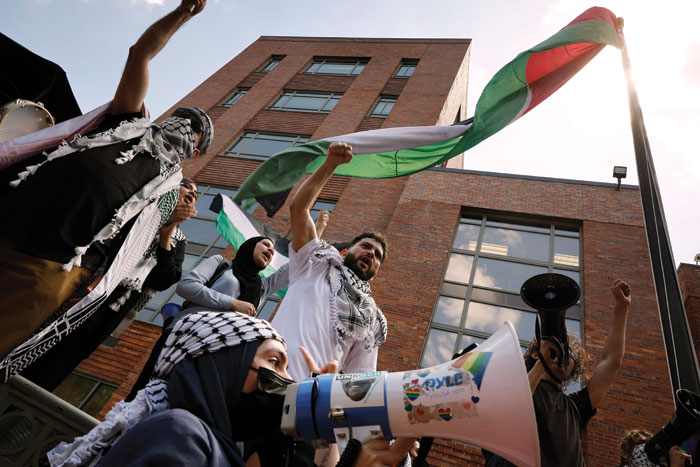 Pro-Palestinian demonstrators block the doors to Bell Hall as they rally on the campus of George Washington University on May 02, 2024 in Washington, DC. (Photo by Chip Somodevilla/Getty Images)
Pro-Palestinian demonstrators block the doors to Bell Hall as they rally on the campus of George Washington University on May 02, 2024 in Washington, DC. (Photo by Chip Somodevilla/Getty Images) The sight of shattered windows in Columbia University buildings; masked, keffiyeh-wearing hoodlums running through halls destroying college property, bloodied protesters, chains of youth blocking the entry of Jewish students into their universities, California Highway Patrol officers lining the University of California, Los Angeles’ encampment, more than 1,000 arrests, and shuttering of universities.
These are some of the scenes the world is watching; scenes that are playing out across Europe, and in Canada and Australia to a lesser degree. Bystanders are in shock, as many ask how this emerged into one of the most disturb-ing Western stories of recent years.
It is the table talk of nearly every Jewish home and of those who respect civilized debate and an inalienable right to free speech that is not being perverted, while U.S.-recognized terrorist organizations’ manifestos are methodically rolling out across the campuses of universities and beyond.
What we’ve seen is just the tip of the iceberg; no university should think the movement has run its course. May 15 marks Nakba (“catastrophe” in Arabic) Day, which commemorates the exodus of more than 700,000 Palestinians who fled or were expelled by Israeli forces during the 1948 war. The timing is not accidental; May 15 was the day after Israel declared its independence. Universities have been warned that an intifada is coming their way on this day.
This week marks Holocaust Remembrance Day, when Jews mourn the 6 million who were systematically exterminated due to racial antisemitism — not being of the pure Aryan race, notes Dr. Charles Small, who heads the Institute for the Study of Global Antisemitism and Policy (ISGAP).
Signs of the weakening of the college campus compass didn’t begin on Oct. 7, when thousands of Hamas terrorists stormed the Gaza border by land, sea, and air to murder, rape, burn, maim, and kidnap Israeli civilians. It began more than two decades ago.
Signs of the weakening of the college campus compass didn’t begin on Oct. 7, when thousands of Hamas terrorists stormed the Gaza border by land, sea, and air to murder, rape, burn, maim, and kidnap Israeli civilians. It began more than two decades ago, evolving into a coordinated and incestuous advocacy framework on behalf of the Palestinian cause and against the Jewish state.
How Pro-Palestinian Movements on Campus Emerged
The Israeli-Palestinian conflict has been brewing for decades prior to and after the formation of the State of Israel which is marking its 76th anniversary.
Twenty-three years ago, toward the end of the Oslo process and the beginning of the Second Intifada, the World Conference against Racism, known as the Durban Conference, took place, charting a course for the antisemitic explosion we are witnessing today.
Professor Gerald Steinberg, who founded and presides over NGO Monitor and has studied NGOs and their accountability for decades, told The Media Line that the Durban Conference, which brought together 5,000 organizations from over 100 countries to adopt a platform to end racial discrimination, was hijacked for the Palestinian cause. This massive event brought together Amnesty International, Human Rights Watch, all the Palestinian NGOs that are using the label of human rights, the Popular Front for the Liberation of Palestine (PFLP), and hundreds of other groups, many of which work closely with the governments of European countries, Canada, and several other countries that partially foot the bill.
The common language used was that Israel was an apartheid, genocidal state that regularly commits ethnic cleansing and war crimes. Some called for the complete isolation of Israel in the international community. Many, including Steinberg, point to this defining moment where the blueprint was established.
In the 1990s and early 2000s, more organized forms of Palestinian support emerged, with the University of California, Berkeley hosting the first Students for Justice in Palestine (SJP) chapter; gradually, its chapters began to multiply on other campuses. Professor Hatem Bazian, a part-time academic who teaches Ethnic Studies at the University of California at Berkeley, is the force behind SJP. Previously, he was a speaker and advocate for the now defunct Islamic Association for Palestine (IAP) and a major fundraiser for an Ohio-based nonprofit, KindHearts. Both IAP and KindHearts were dissolved after legal battles due to allegations that they raised money for Hamas. In 2004, IAP was shut down after it was found liable in civil court for aiding and abetting in a terrorist attack that killed an American boy. The U.S. Treasury Department sanctioned KindHearts in 2006 for supporting Hamas, which led to litigation, a settlement, and the organization’s dissolving in 2012.
“You see various versions of this. It’s not just Students for Justice in Palestine,” Steinberg said. “You see an ostensibly Jewish framework of support, a fig leaf called Jewish Voice for Peace (JVP), the largest progressive anti-Zionist Jewish organization, that began to establish branches and said, we’re the Jewish branch of the Palestinian movement, very closely working with and cooperating with SJP, the U.S. Campaign for Palestinian Rights [USCPR]and other organizations like that.”
“Simultaneously you have these human rights groups that are active on campuses, some of which are linked to the PFLP. You see them doing programs in law schools and in the Middle East Studies Program, where you see these individuals, the heads of these organizations, and they’re within a quasi- or pseudo-academic framework. These are often not academics. Sometimes they’re perpetual students, sometimes they’re not. Sometimes they’re faculty support.” Steinberg said.
To understand the context of the “pro-Palestine” movement’s origins, one needs to view the historical background of these groups and the blurring of lines between these organizations.
Samidoun is the NGO representation of the PFLP on university campuses, and according to Steinberg, active in this group. He notes, “It’s sometimes hard to tell the difference, and I don’t mean that in a casual sense. It’s hard for anybody like NGO-Monitor, who looks at the organizations, to see the division.
“‘They seem to’ is probably an understatement. They often work together in these kinds of events and conferences. And you see them sharing resources.”
Asked if there is direct proof that these groups are associated with the PFLP, Steinberg added, “There’s no question about it; they are linked to the PFLP.
“They use PFLP symbols now in various campuses, all of a sudden, something you never saw before. I’m sure 90% of those students have no idea what those symbols are.
“They are not Hamas, but it’s important to note the PFLP participated in the events of Oct. 7. They held and may still be holding hostages in Gaza.”
The Pillars of Funding and Consequences
I asked Dr. Steinberg to illustrate the current funding pattern for the reader, based on a report he just released. This does include other foundations, such as the Ford Foundation, that provided significant funding in the past. In October 2023, the Ford Foundation announced that it had severed ties with the Arizona-based Alliance for Global Justice (AFGJ) due to its alleged links to Palestinian terrorist groups. This decision was made following an investigation by the Washington Examiner and amid concerns raised after the Oct. 7 attacks in Israel.
“We see that came out right after Oct. 7, and SJP came out with a sort of guidebook to tell all their people how to, what they should be doing, the slogans, the signs, the actions that were taken.” – Dr. Gerald Steinberg
“We see the bottom layer, the ground layer and that’s all these mobs and encampments. … And we see the coordination between them all. We see that came out right after Oct. 7, and SJP came out with a sort of guidebook to tell all their people how to, what they should be doing, the slogans, the signs, the actions that were taken. That’s visible.
“And then comes the question, who’s funding them? And that’s hidden, (though) not entirely. And it’s deliberately hidden.”
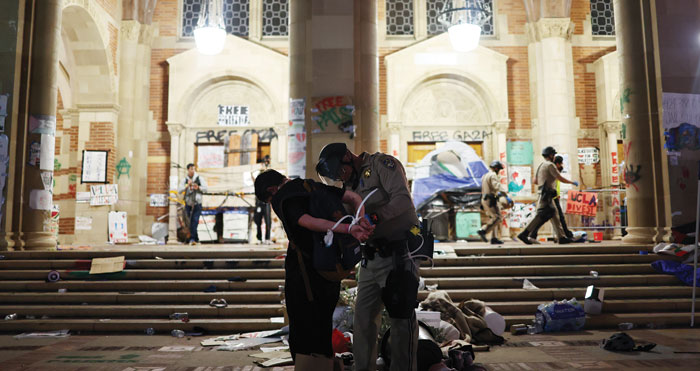
Most political PACs, action committees, and NGOs that promote causes are registered with the IRS as nonprofits. According to Steinberg, “These organizations don’t do that.” There are no records, nor receipts, but a concealed operation runs through fiscal sponsors he calls pass-throughs, which are registered with the IRS.
1. The Rockefeller Brothers Fund provided the largest amount over the years. It is headed by President and CEO Stephen Heintz, who was Senator Joe Lieberman’s (I-Conn.) chief of staff. Steinberg says they have pushed this funding under the false label of Middle East peace and will have to answer to the campus takeovers and attacks against Jews. “Heintz is hands-on,” he says.
2. The Open Society Foundation, which was established by George Soros, has funded JVP, which has supported protests across the US since the Oct. 7 attack. The Open Society provides hundreds of thousands of dollars in multiyear contracts.
Steinberg doesn’t think it is right to single out Soros. “Soros is a diversion and exaggeration. The funding has been irresponsible but doesn’t come to the level of the Rockefeller Brothers Fund. Unlike Heintz, Soros does not get involved personally in his empire, certainly not for the last decade.”
3. The Tides Foundation is another pass-through. It receives funding from various donors, including Rockefeller Brothers and Open Society, and dispenses funding, for example to JVP, IfNotNow (INN), and Palestine Legal. There is no direct link between donors and recipients, allowing donors to hide their involvement.
4. Samidoun, the Palestinian Prisoner Solidarity Network, was founded in 2012 and was a major organizer in the Day of Rage and Day of Resistance. Its chief coordinator is Khaled Barakat, head of the PLFP abroad. In 2023, the German government banned it. In April this year, the Belgian government moved to revoke the refugee status of Mohammed Khatib, its European coordinator. Israel designated it as a terrorist organization and part of the PFLP in 2021, but Canada hosts the registered nonprofit in Vancouver. The US has not banned the organization though the PFLP is a designated terrorist organization.
According to Steinberg, Samidoun has the most visible terror connections through Hatem Bazian and SJP, but it is much more indirect and problematic in terms of the legal process. It is most visible in terms of its connections to the PFLP and has greatly increased its activity since Oct. 7.
It has been much more active in Europe but now has increased its activity and visibility on U.S. college campuses. The international coordinator, Charlotte Kates, was featured with Dr. Basem Naim, a senior Hamas official who described the Oct. 7 attack as a “heroic operation.” Samidoun has co-sponsored events led by Within Our Lifetime (WOL) and the Palestinian Youth Movement (PYM).
Samidoun’s website boasts a network of chapters and affiliates in the U.S., Canada, Germany, Britain, France, Sweden, the Netherlands, Belgium, Greece, Spain, Palestine, and Lebanon. It collects donations through the AFGJ.
The Israel-based Zachor Legal Institute brought an action against AFGJ and subsequently, in 2023 its online credit card donations, which fund 140 organizations, were shut down. The website currently states: “AFGJ cannot currently accept credit donations” and encourages donations via paper checks.
5. Westchester Peace Action Committee (WESPAC Foundation), a White Plains, New York-based foundation, is a Palestinian pass-through. Although it is registered with the IRS, it does not have to report where its money comes from.
Fourth-generation cantor Deborah Katchko-Gray, a Good Samaritan and founding member of Women Fighting Antisemitism, has been following the money trail for years. She told The Media Line that WESPAC is behind much of the funding that fuels the anti-Israel protests.
WESPAC is a 501(c)(3) that processes donations for several anti-Israel organizations, including WOL and SJP.
SJP has a long history of antisemitic activities across university campuses and easy access to several US politicians. It opposes anything connected to the State of Israel.
An SJP chapter once protested because of the availability of Sabra hummus at Northwestern University. SJP also sponsored the Oct. 12, 2023 Day of Resistance on college campuses across the US. Its flyers celebrated the Hamas “resistance” that swooped into Israel on Oct. 7 on paragliders, trucks, and boats. While WESPAC is open about its association with organizations like SJP, it is not so open about how it receives its funding.
“They support terror, quite honestly,” Katchko-Gray told The Media Line. “I know that Rep. Jamaal Bowman (D-N.Y.) probably is protecting WESPAC. He’s part of ‘The Squad,’” she says, referring to the nine congressional Democrats who occupy the left flank of American politics and are vocal opponents of Israel. “And it’s his district that they exist under,” she continued.
After Columbia University suspended SJP and JVP last November, New York Democratic Reps. Bowman, Nydia Velázquez and Alexandria Ocasio-Cortez signed a letter in support of the anti-Israel organizations.
6. National Students for Justice in Palestine (NSJP), JVP, INN, WOL, and USCPR are organizations that are directly involved in the protests and have substantial hidden funding.
NSJP, WOL, and Samidoun are not registered with the IRS and are entirely nontransparent, receiving funds anonymously through “fiscal sponsors.”
JVP and USCPR are registered as tax-exempt entities but are not required to report on their donors and income sources. Some of their donors, such as Rockefeller Brothers and Open Society, report on funding these groups, but most of their funding is hidden.
The websites of some of these organizations utilize pass-throughs, as well. For example, when you go to the donate link on the NSJP site, it takes you to WESPAC.
INN collects tax-deductible donations for its IfNotNow Education Fund through ActBlue Charities, “a qualified 501(c)(3) tax-exempt organization.” In FY 2021-2022, total income was $514,447 and total expenses were $460,014. It also operates the IfNotNow Movement, a 501(c)(4) organization. Donations to the movement are not tax-deductible. In FY 2021-2022, total income was $170,142; total expenses were $138,258.
IfNotNow does not report any donor information or sources of funding on its website, reflecting a complete lack of transparency and accountability. Independent research shows that, between 2017 and 2023, IfNotNow received $160,000 from the Rockefeller Brothers Fund “for general support.”
7. Another pass-through is a group of brokerage firms such as Goldman Sachs, Charles Schwab and Lehman Brothers, which enable their clients to donate anonymously to registered NGOs like JVP and USCPR and get tax deductions. Individuals, corporations and foreign entities can have accounts and direct their charitable contributions so their names don’t appear.
Steinberg says that groups like SJP, USCPR and Samidoun are major operations run by a tightly connected network of Muslims and Arabs, where people move from one organization to another. These people one day are seen organizing an event at CUNY in New York, and then at Hunter College and now Columbia. “You can’t be a student at all simultaneously, but maybe somebody wants to pay tuition,” he tells The Media Line. “Obviously they have to have salaries, travel funding, there’s social media, and how many of them are there, and who’s paying their salaries?”
Steinberg estimates that around $3 million in visible annual funding has been funneled into the coffers of these organizations but it’s hard to define the amounts due to the lack of transparency. SJP is not registered with the IRS or in any other format as a legal entity.
Ariel Beery, a 2005 Columbia University graduate, discussed the strategy of Israel’s enemies. He told The Media Line that when unable to defeat Israel militarily, they have turned to soft power and funding guerrilla groups to challenge Israel. These protests represent the soft power of Israel’s enemies.
“Anti-Western interests recognized that the leverage point was students and professors,” he stated.
Beery also highlighted the influence of certain academic and financial practices at Columbia during his time there. “As a student at Columbia from 2002 to 2005, I worked at the Middle East Institute as a research assistant. One of my regular duties was to type up and send thank-you notes from the director to various donors, most of whom were oil companies, or their proxy organizations and foundations. Nearly none of these were reported by the university at the time,” he said.
“Many donations,” he asserted, “are made just below the legal reporting requirement.
“As a research assistant at the Middle East Institute, I observed how donations just below the legal reporting requirement influenced the curriculum,” he revealed. According to Beery, these contributions supported courses in local high schools that presented a curriculum biased against Israel, perpetuating negative perceptions among young students.
“One day, the new director, Rashid Khalidi, who sat on a newly donated Edward Said Chair, asked me to send a letter he wrote to Saudi Aramco,” Beery said.
“In the letter, he thanked them for their generous donation to enable professors from the institute to teach a course on Middle East Studies in local high schools using a curriculum not friendly toward Israel. Courses such as that one have persisted for decades. This is one reason hundreds of high school students in New York find the motivation to protest Israel and target their teachers. Such programs were regularly sponsored, a visible example of how Israel’s enemies worked first to capture academic departments and then to propagate messages throughout the next generation of politicians, business, and community leaders,” Beery concluded.
Who Are the Protesters?
The Palestinian minority is less than 200,000 strong among a population of 333 million Americans, and yet they have managed to disrupt and tear down university campuses through a highly organized assault in a matter of mere weeks.
An attempted occupation at Arizona State University highlights another major issue college campuses are facing: Most of the protesters are not students.
An attempted occupation at Arizona State University highlights another major issue college campuses are facing: Most of the protesters are not students.
Several weeks ago, 72 people were arrested for trying to replicate the Columbia University encampment on a grass patch at ASU’s main campus in Tempe. Nearly 75,000 students attend the campus; fewer than 80 people arrived for the protest. Of the six dozen protesters arrested throughout the day, 15 were ASU students; almost 80% of those arrested were not students, an ASU spokesperson told The Media Line.
New York City Mayor Eric Adams said the protesters there had been “co-opted by professional outside agitators.”
The Media Line sent a reporter to several protests. In an encampment at the University of California, San Diego, Subrein Damanhoury, an organizer with PYM and media liaison for the encampment, told The Media Line that protesters were calling on UCSD to “divest all funds [from Israel].”
The Media Line counted roughly 30 tents within the confines of the fenced off encampment. The protesters plan to stay until the university meets their demands for UCSD to divest from Israel but were unable to identify how UCSD is currently connected to Israel, if at all, financially. The group also opposes Israel study abroad programs and university-funded research collaborations with Israel. “There’s a lot of stuff we could be funding instead of funding a military regime and occupation apartheid,” Damanhoury said.
An estimated 500 people were at the UCSD encampment, many of whom police believed to be unaffiliated with UCSD, including protesters from the UCLA and Columbia encampments, as well as members of the Black Panthers.
Why a Small Country Like Qatar Is Funding U.S. Universities
Qatar is one of the smallest countries in the Persian Gulf, sharing its only land border with Saudi Arabia. It maintains close ties with the Taliban and al-Qaida; shares a natural gas field with Iran; and funds and supports the Muslim Brotherhood. Hosting a U.S. military base, it also has good relations with the West as a large energy supplier. Qatar enjoys the perception of neutrality and has been a power broker in hostage releases in the past and between representatives of Israel, Hamas and the U.S. negotiating a cease-fire and hostage release deal. And it is leveraging its power and influence by pouring money into universities, buying up football teams and spreading its messages through the state-owned Al Jazeera news network.
Emphasizing this, Dr. Small asked a group of journalists why a small Gulf country like Qatar, with around 350,000 citizens and a total population of 2.7 million, gives more money to American and European universities than China, Russia, Canada, and European allies.
Qatar’s royal family, Small says, has taken a bayah, a spiritual oath, to the Muslim Brotherhood. As a result, the infamous antisemitic text “The Protocols of the Elders of Zion” plays a central role in their interpretation of Islam.

ISGAP’s Dr. Small points to the late Muslim Brotherhood spiritual leader Yusuf al-Qaradawi, who brought Islamic studies to Oxford — where Small earned his doctorate — and who argued that the true Muslim is obligated to complete the work of Hitler.
“This was the core element of the teachings that are followed by the Qatari regime. So the Qatari regime’s goal and the Muslim Brotherhood’s goal is to remove and isolate, distance Israel from the West and from the U.S., to destroy it, and to use antisemitism as a way to fragment and weaken and then destroy ‘the Great Satan,’ the United States,” Small says.
Small said that SJP was kind of born out of American Muslims for Palestine (AMP), which is an American Muslim Brotherhood organization. The report stated that AMP’s legal counsel said they were funding groups such as SJP and JVP.
ISGAP just released a 73-page report claiming that Hamas-linked funds provided grants of up to $2,000 each for the programs and activities of pro-Palestinian groups. Small said that SJP was kind of born out of American Muslims for Palestine (AMP), which is an American Muslim Brotherhood organization. The report stated that AMP’s legal counsel said they were funding groups such as SJP and JVP.
Several months ago, ISGAP revealed that Texas A&M had a $1.3 billion contract with the Qatar Foundation. ISGAP also uncovered 502 research projects for which Texas A&M gave all the intellectual property rights to the Qataris.
Several months ago, ISGAP revealed that Texas A&M had a $1.3 billion contract with the Qatar Foundation. ISGAP also uncovered 502 research projects for which Texas A&M gave all the intellectual property rights to the Qataris.
Dr. Small said that his institute flagged 58 research projects that the Qataris now own with dual-use military and even nuclear research with military implications.
Cornell was among the list of Qatari-funded universities, receiving a $1.9 billion gift and an $8 billion infrastructure program donation.
Cornell was among the list of Qatari-funded universities, receiving a $1.9 billion gift and an $8 billion infrastructure program donation, with which Qatar built the medical school hospital and research center for the Cornell University campus in its capital, Doha.
The Qatari Embassy released a statement on May 2 claiming that disinformation was being spread about Qatar’s relationship with certain U.S. universities, and that “Qatari donations provided to U.S. universities are allocated to the operating costs of branch campuses in Qatar, funding construction and maintenance, faculty salaries and other costs incurred in Qatar — not in the United States.” The embassy insisted that “Qatar never interferes in the educational content or curriculum of any American school, college, or university.”
Laws in the U.S. require foreign gifts of over $250,000 to universities or nonprofit organizations to be reported to the Department of Education and the IRS. These laws are not being enforced effectively, according to Small.
Steinberg calls on universities to transparently disclose their funding sources to the U.S. government and to their stakeholders — their funders, faculty, and students — and demands basic transparency and scrutiny regarding anti-democratic and hateful entities that could be influencing academia.
Asked what actions need to be taken, Small quipped, “We are calling on the Texas government and federal government to investigate their reports on Texas A&M.” “They’re closing their campus [in Doha] based on our report. I think that sent shockwaves through the Texas A&M community.”
Asked what actions need to be taken, Small quipped, “We are calling on the Texas government and federal government to investigate their reports on Texas A&M.” “They’re closing their campus [in Doha] based on our report. I think that sent shockwaves through the Texas A&M community.”
Looking toward Europe, the U.K. has seen protests for months organized by the Palestine Solidarity Campaign, but the recent spate of protests, including encampments, mirrors those in the US. However, the response structure lies with the public safety echelon. Tom Southerden, Amnesty International U.K.’s program director for law and human rights, told The Media Line that it’s up to the police, not the universities, to determine whether to act against protesters.
In a sad, developing story, Columbia University and the University of Southern California announced that they were canceling their main commencement ceremonies.
A deep understanding of the breakdown of America’s pillars of education, the causes, and the funding, in addition to a united front on the governmental, university leadership, and organizational levels will only begin to bring American academia back to its core values, so that the U.S. and the civilized world’s valued interests are preserved and students can feel safe to learn in a free and democratic society, not with chains of intimidation, fear and hate.
Clint Van Winkle and Nathan Klabin contributed to this report.
Felice Friedson is president and CEO of The Media Line news agency and founder of the Press and Policy Student Program, the Mideast Press Club, and the Women’s Empowerment Program. She can be reached at ffriedson@themedialine.org.







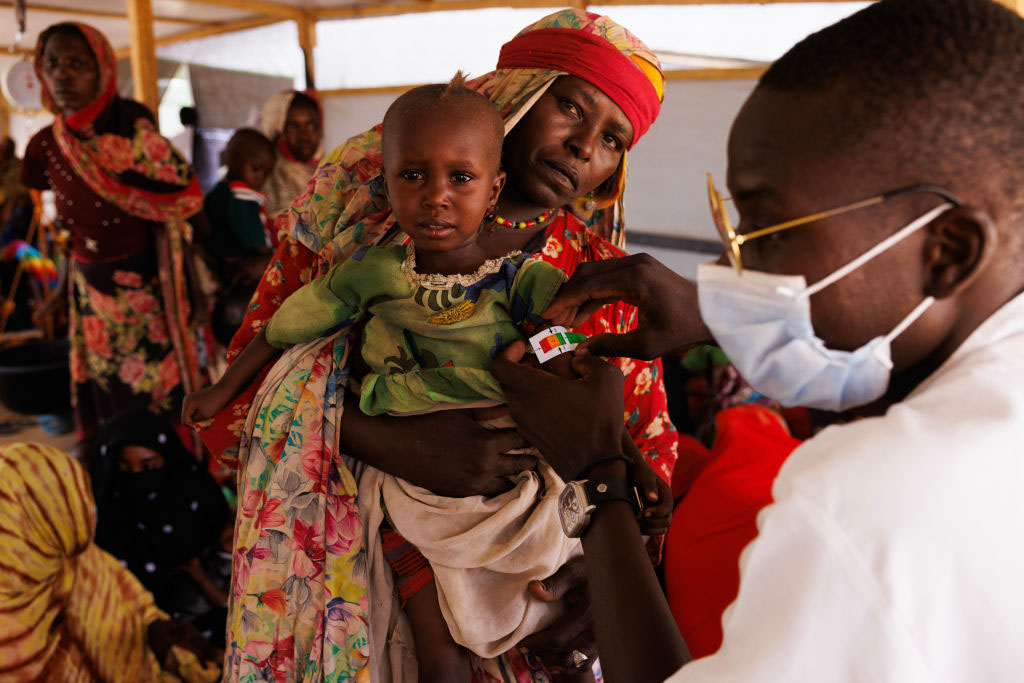


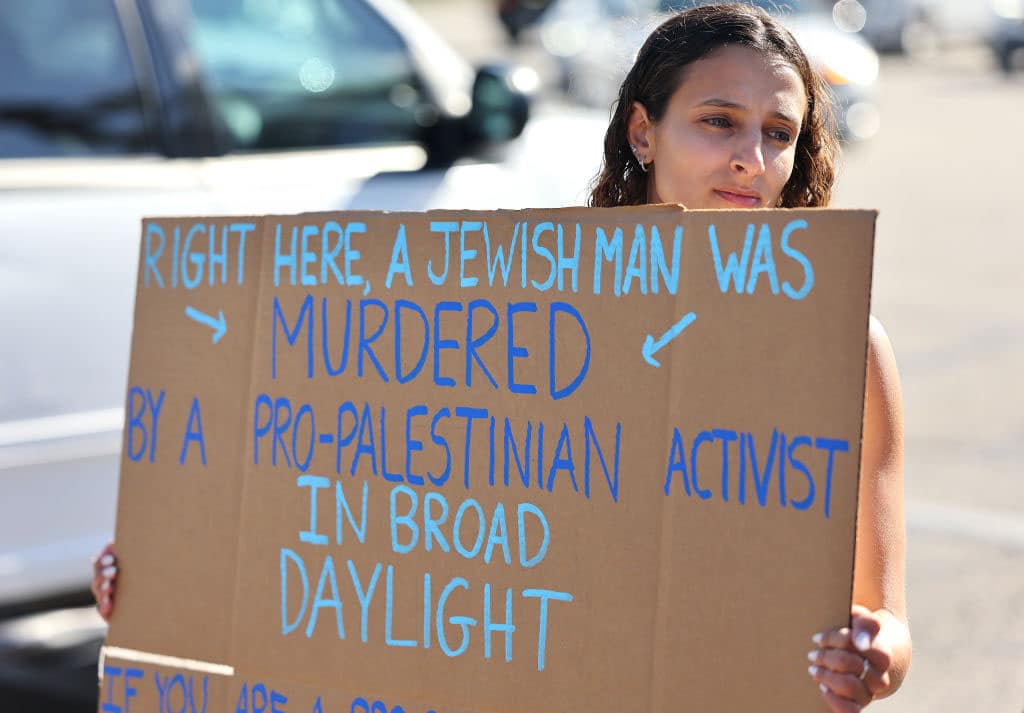




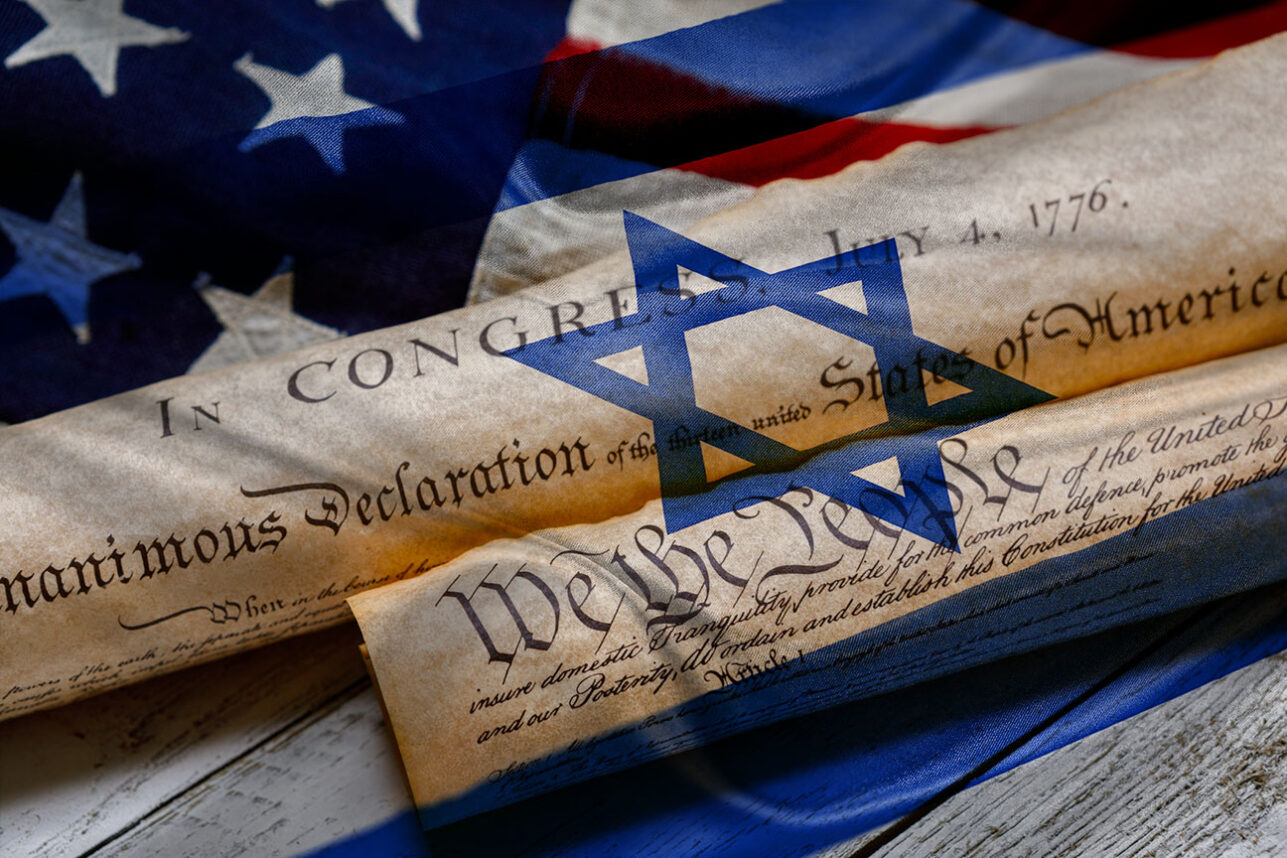







 More news and opinions than at a Shabbat dinner, right in your inbox.
More news and opinions than at a Shabbat dinner, right in your inbox.